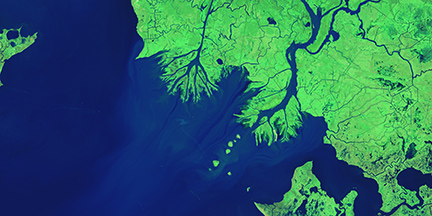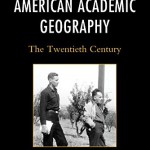IMAGE OF THE WEEK

The snow-covered northeastern states as observed on Feb. 16, 2015, by the Moderate Resolution Imaging Spectroradiometer (MODIS) on NASA’s Terra satellite. Image Credit: NASA/Jeff Schmaltz, LANCE/EOSDIS Rapid Response, NASA Goddard Space Flight Center
Yet another potent winter storm battered the northeastern United States on Feb. 14-15, 2015. The nor’easter brought 12 to 20 inches (30 to 50 centimeters) of snow across much of eastern New England, along with tropical storm force winds over 60 miles (100 kilometers) per hour. The latest snowfall pushed Boston to its highest monthly total on record—58 inches and counting—and its third highest yearly snow total.
GOOD NEWS
Aparna Parikh received the Susan Hansen Dissertation Proposal Award from the AAG Geographic Perspectives on Women specialty group.
THON was a spectacular success again this year! Our EMS Student Council did an outstanding job toward helping THON again raise more than $13 million For the Kids. For the fifth year in a row, the College of EMS Benefiting THON is the top General Organization, raising $137,763.29 to smash last year’s previous EMS record.
NEWS
Coffee Hour: February 27 Diansheng Guo “Computational, Visual and Statistical Analysis of Geographic Mobility”
Geographic mobility data has become increasingly available with the wide use of location-aware devices and technologies, which provide unprecedented opportunities to capture and understand the dynamics of complex systems such as transportation, urban system, demography and ecology. However, it remains a challenging research problem to analyze, visualize and understand big mobility data due to the complexity of patterns, unknown structures in mobility, and the constrained map space.
- 3:30 to 5:00 p.m.
- Refreshments are offered in 319 Walker Building at 3:30 p.m.
- The lecture begins in 112 Walker Building at 4:00 p.m.
- Coffee Hour To Go
Three geography students win USGIF Scholarships
Every year, the United States Geospatial Intelligence Foundation honors a range of students interested in using geospatial science to address human security challenges. Open to graduating high school seniors, and undergraduate, graduate, and doctoral students, the USGIF chooses applicants based on an application process that evaluates academic and professional accomplishments in fields related to geospatial intelligence. The 2014 Scholarship Program winners included three Penn State students; undergraduate Everleigh Stokes and graduate students Seth LeMaster and Nouman Hussain.
GIS Coalition is an organization that offers students majoring, minoring, or sharing an interest in GIS opportunities to develop supplementary knowledge and skills necessary to succeed in the professional GIS industry. “We want to enhance in-class teaching of GIS, and better prepare students for careers through speakers and out of class activities,” said president Blake Naito, currently a junior majoring in Geography, GIS option.
Recently (or soon to be) published
Tree-ring δ 13C tracks flux tower ecosystem productivity estimates in a NE temperate forest. Soumaya Belmecheri, R Stockton Maxwell, Alan H Taylor, Kenneth J Davis, Katherine H Freeman and William J Munger. 2014 Environ. Res. Lett. 9 074011 doi:10.1088/1748-9326/9/7/074011
We investigated relationships between tree-ring δ13C and growth, and flux tower estimates of gross primary productivity (GPP) at Harvard Forest from 1992 to 2010. Seasonal variations of derived photosynthetic isotope discrimination (Δ13C) and leaf intercellular CO2 concentration (c i ) showed significant increasing trends for the dominant deciduous and coniferous species. Δ13C was positively correlated to growing-season GPP and is primarily controlled by precipitation and soil moisture indicating that site conditions maintained high stomatal conductance under increasing atmospheric CO2 levels. Increasing Δ13C over the 1992–2010 period is attributed to increasing annual and summer water availability identified at Harvard Forest and across the region. Higher Δ13C is coincident with an enhancement in growth and ecosystem-level net carbon uptake. This work suggests that tree-ring δ13C could serve as a measure of forest GPP and be used to improve the calibration and predictive skill of ecosystem and carbon cycle models.
Applications now being accepted for the Student Sustainability Advisory Council
Applications are due March 6
The Penn State Student Sustainability Advisory Council is comprised of students who are committed to helping to advance Penn State’s strategic goals for sustainability. Appointed faculty and administrators from the Sustainability Institute, Finance and Business and Student Affairs are also members of the Council and they provide resources, support and assistance to help the SSAC explore ideas and implement recommendations. The Council provides consultation and advice on Penn State sustainability planning, programs, and initiatives.
DOG OF THE WEEK
Last week’s dog was Fenway, companion to Rob and Becky Brooks. Hannah Ingram was the first to correctly identify him. Send a photo of your dog to geography@psu.edu for our mystery dog of the week!







